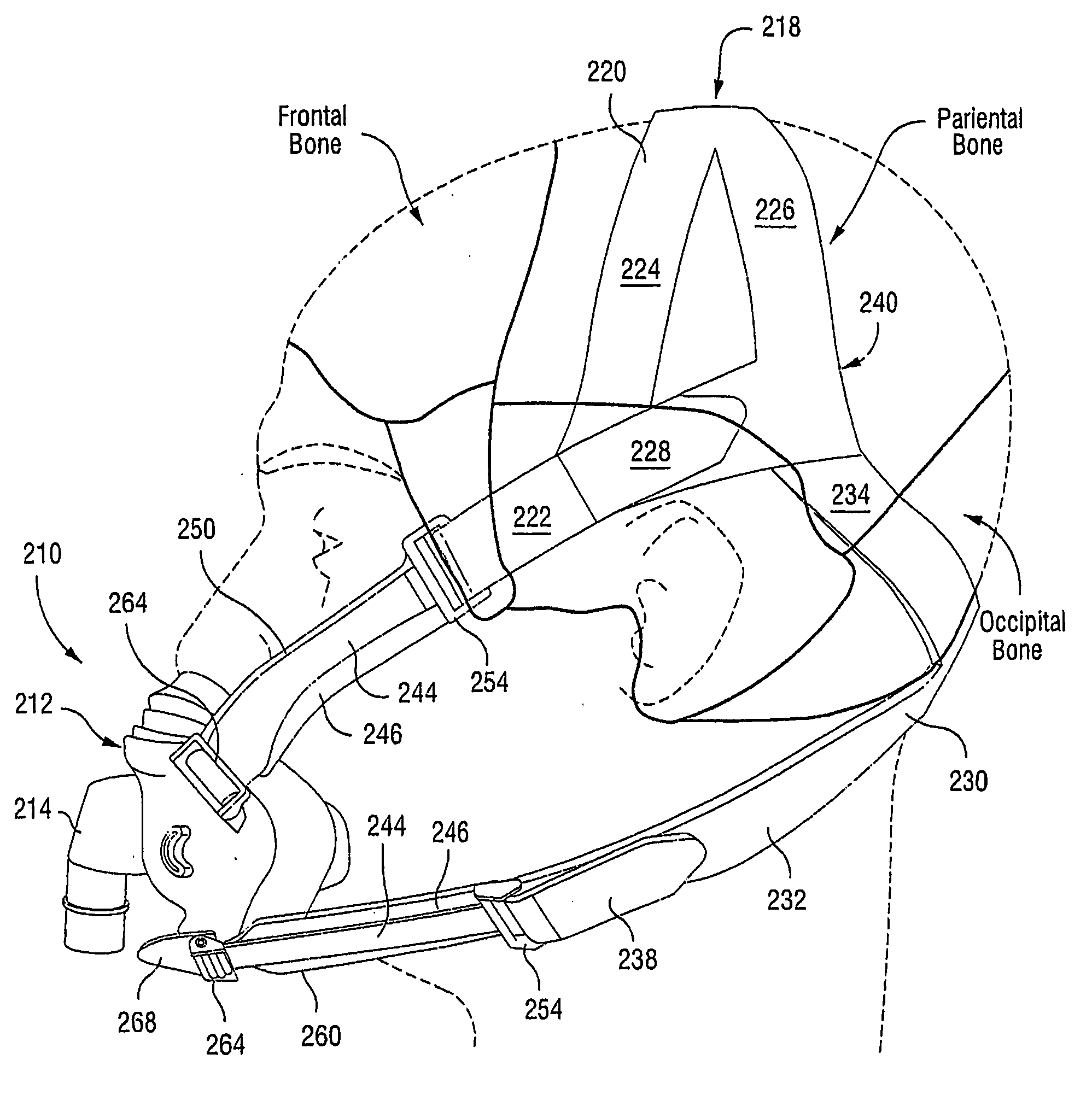Mask System
a mask and mask technology, applied in the field of mask systems, can solve the problems of increased treatment pressure, ineffectiveness of the nasal mask type patient interface, and mouth leakage, and achieve the effect of quiet exhalation gas washout, effective and simple us
- Summary
- Abstract
- Description
- Claims
- Application Information
AI Technical Summary
Benefits of technology
Problems solved by technology
Method used
Image
Examples
first embodiment
§1.1.3.1 First Embodiment Headgear
[0170]As illustrated in FIGS. 1, 11, and 12, the upper stabilizing straps 250 are removably connected to an upper portion of the frame 274, and the lower stabilizing straps 260 are removably connected to a lower portion of the frame 274.
[0171]As shown in FIGS. 11 and 12, each of the upper and lower stabilizing straps 250, 260 includes a strap attachment member 254 secured at one end and a frame attachment member 264 secured at the opposite end. The strap attachment member 254 includes a crossbar that enables the end portion of the respective top and bottom strap portion 222, 232 to be wrapped around, in a known manner. The free end of each of the top and bottom strap portions 222, 232 includes a strip of Velcro® material 228,238 that engages the remainder of the strap portion to adjustably pull or secure the strap attachment member 254 in place. Thus, the length of the top and bottom strap portions 222, 232 maybe easily adjusted. However, other adju...
second embodiment
§1.1.3.2 Second Embodiment
[0178]In an alternative embodiment, the frame attachment member of each of the lower stabilizing straps 260 may be in the form of a locking clip 364. As shown in FIGS. 19-21, the locking clip 364 includes upper and lower arms 365, 367 that are resiliently flexible towards one another. Also, the upper arm 365 includes spaced-apart protrusions 369. In an embodiment, the locking clip 364 is molded in one-piece along with the yoke section 244 of the respective lower stabilizing strap 260. Alternatively, the locking clip 364 maybe formed separately from the yoke section 244 and attached thereto, e.g., by an adhesive or rotational connection, etc.
[0179]As shown in FIGS. 22-23, the frame 274 is provided with clip receptacles 371 on each side frame member thereof. Each clip receptacle 371 includes spaced-apart slots 373. In use, each clip 364 is interlocked with a respective clip receptacle 371 by first moving the clip 364 into the respective clip receptacle 371 su...
third embodiment
§1.1.3.3 Third Embodiment
[0181]In another alternative embodiment, the frame attachment member of each of the upper and lower stabilizing straps 250, 260 may be in the form of a press-stud type interface. As shown in FIGS. 24-25, the end of each stabilizing strap 250, 260 includes a protruding stud 465. A soft flexible finger tab 468 is provided on the end of each stabilizing strap to facilitate engagement and disengagement to the frame 274.
[0182]The frame 274 is provided with stud receivers on each side frame member thereof. In use, each stud 465 is press-fit into a respective stud receiver. This arrangement allows the stabilizing straps 250, 260 to rotate with respect to the frame 274 to allow the mask system to align on the patient's face. In an alternative embodiment, the studs 465 may be provided on the frame 274 and the stud receivers may be provided on the stabilizing straps 250, 260.
§1.1.4 Alternative Stabilizing Systems
[0183]FIGS. 26-29 illustrate alternative embodiments for...
PUM
| Property | Measurement | Unit |
|---|---|---|
| thick | aaaaa | aaaaa |
| thickness | aaaaa | aaaaa |
| thickness | aaaaa | aaaaa |
Abstract
Description
Claims
Application Information
 Login to View More
Login to View More - R&D
- Intellectual Property
- Life Sciences
- Materials
- Tech Scout
- Unparalleled Data Quality
- Higher Quality Content
- 60% Fewer Hallucinations
Browse by: Latest US Patents, China's latest patents, Technical Efficacy Thesaurus, Application Domain, Technology Topic, Popular Technical Reports.
© 2025 PatSnap. All rights reserved.Legal|Privacy policy|Modern Slavery Act Transparency Statement|Sitemap|About US| Contact US: help@patsnap.com



